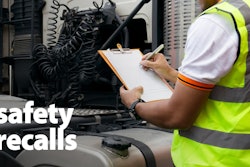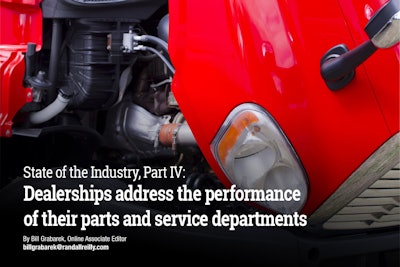
Palmer Trucks’ parts department had its strongest year in 2019, says Jacob Nichols, director of corporate operations. “Technology has enabled the business to inform and communicate with customers efficiently to solve their complex needs.”
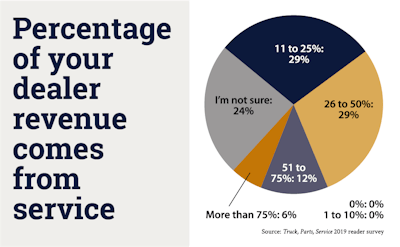 Click to enlarge.
Click to enlarge.Nichols says all of Palmer Trucks’ service facilities are at capacity and customers have responded well to mobile-service units used to supplement operations at customer-operated facilities. And, despite the challenge of finding skilled technicians, Palmer Trucks has been able to add repair services to meet demands, he says.
Dealerships responding to a 2019 Trucks, Parts, Service reader survey reported the labor availability and costs of technicians as their top business concern. (Editor’s note: The technician shortage in the aftermarket and dealer channels will be addressed in Part VI of the TPS State of the Industry report.)
Jerry Kocan, dealer principal, reports Four Star Freightliner’s parts business was up in 2019 over the previous year. He says the lift is likely because of the popularity of Daimler’s Pinnacle Truck Parts and Alliance Truck Parts.
“We’re selling more of what people call non-OEM even though they’re made by an OEM but they’re discounted. The e-commerce that they’re providing for us has helped, too,” he says.
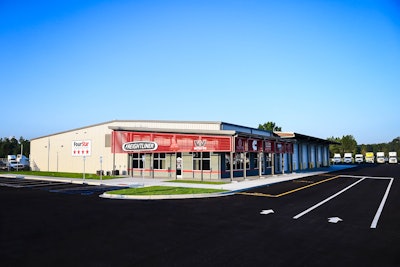 Four Star Freightliner tripled the number of mobile service trucks in the last three years and added seven delivery trucks over the last two years.
Four Star Freightliner tripled the number of mobile service trucks in the last three years and added seven delivery trucks over the last two years.While the dealer group had a nice lift in parts, service didn’t meet company expectations. The locations that got hit the hardest were those located near major interstates.
Kocan says Four Star’s service bays were seeing less of the large carriers because freight rates didn’t make financial sense to them. As a result, smaller carriers were carrying those loads. With the larger carriers came scale and Four Star Freightliner wasn’t getting it.
“We saw a mix of new customers we hadn’t seen, so we had to rely on the transient guy coming through needing something — not just your basic upkeep, maintenance or warranty work. He would have to have an event,” Kocan says.
Despite the downturn in the amount of service in Four Star Freightliner bays, Kocan says customers are wanting support locations closer to them. To meet customer service needs, the company tripled the number of mobile service trucks in the last three years and added seven delivery trucks over the last two years.
“We’ve had to make their lives easier because they have a lot of regulations, especially with their drivers. So them sending a driver to deliver a truck to get service is not something they can always do so we’ve tried to work with the customer in an effort to make it simpler,” Kocan says. Four Star will send over a mobile service truck and complete several jobs for the customer on-site.
The dealership now has more than 30 delivery trucks because “customers are wanting parts multiple times of day now,” Kocan says. “We’ve invested in delivery trucks and it’s helped gain customers in areas that maybe we couldn’t have before.”
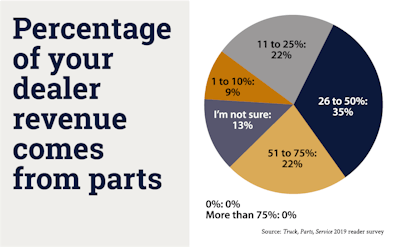 Click to enlarge.
Click to enlarge.Hunter Truck President and CEO Jeff Hunter says there was much more pricing pressure on parts in 2019 as the economy continues to become more global. He says two strategically located warehouses housing a wide breadth of inventory and Hunter Truck’s distribution system “allow us to remain very competitive. We had a record year [in 2018] with Paccar and International parts and we’re on pace to have a record year with both of them again [in 2019].”
What’s more, the company’s 150 delivery trucks eliminate customers’ down time by getting parts to them quickly.
At Fyda Freightliner, performance of its service and parts departments in 2019 are comparable to the previous year, which is to say is a high level, Dealer Principal Tim Fyda says.
Regarding parts, the company has focused in recent years on providing more Alliance Parts and have seen growth in that area. “We’re going to open a standalone Alliance Parts in Columbus, Ohio. It should be done in the first half of 2020,” Fyda says.
Neal Truck and Bus Center had a stronger year in 2019 compared with 2018 on the parts side of the business.
 K. Neal Truck and Bus Center had a stronger year in 2019 compared with 2018 on the parts side of the business.
K. Neal Truck and Bus Center had a stronger year in 2019 compared with 2018 on the parts side of the business.“In Q1 of 2019, we didn’t come out of the blocks the way we wanted to but we hit our stride, selling commodities such as batteries, filters, coolers and cleaners,” says Korey Neal, president, adding the OEMs offering all-makes brands enables the dealership to sell parts to customers even if the dealership didn’t sell them their trucks. In addition, the dealership added three outside sales representatives last year, which has boosted parts sales, he adds.
Neal says service has been steady year over year.
“Customers continue to want their trucks out of the shop more quickly. So we are faced with that demand just like every other dealership in the country,” he says, adding, “Service is ever-changing with the improvement of vehicles and technology.”
(Editor’s note: Part V of the TPS State of the Industry examines dealerships’ views of their business in 2020. It will appear in TPS Daily on Wednesday, Jan. 8.)



